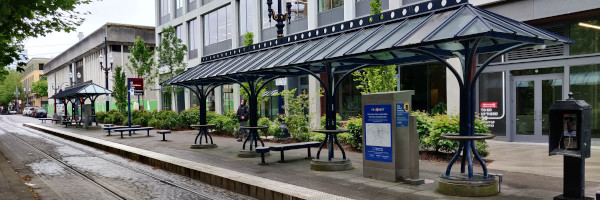Mobility Hubs: Difference between revisions
No edit summary |
No edit summary |
||
| Line 1: | Line 1: | ||
{{Chapter | {{Chapter | ||
| | |image=MobilityHub.jpg | ||
| | |poc=Wilfred Pinfold | ||
| authors = Wilfred Pinfold, Skip Newberry, Jeff Allen, Ken Montler, Timothy Smith, Joe Cortright, Greta Knappenberger, Jill Sorensen, John Feo, Corey Marshall, Jose Gonzalez, Geoffrey Urbach | |authors=Wilfred Pinfold, Skip Newberry, Jeff Allen, Ken Montler, Timothy Smith, Joe Cortright, Greta Knappenberger, Jill Sorensen, John Feo, Corey Marshall, Jose Gonzalez, Geoffrey Urbach | ||
| | |blueprint=Transportation | ||
|chapter=5004 | |||
|sectors=Transportation, Utility | |||
| chapter = 5004 | |summary=Any transit stop can be turned into a Mobility hub where the first and last mile vehicles are serviced, charged and stored when not in service. At these | ||
| | |||
| summary = Any transit stop can be turned into a Mobility hub where the first and last mile vehicles are serviced, charged and stored when not in service. At these | |||
hubs passenger experience can be improved with digital information signs that respond to real-time conditions, improved lighting, improved pedestrian | hubs passenger experience can be improved with digital information signs that respond to real-time conditions, improved lighting, improved pedestrian | ||
safety, bike racks, improved safety including CCTV cameras, and much more. | safety, bike racks, improved safety including CCTV cameras, and much more. | ||
|email=wilfred.pinfold@opencommons.org | |||
|document=TransportationBlueprintFeb18.pdf | |||
}} | }} | ||
A mobility hub is a transportation facility that provides multiple modes of transportation and serves as a central point for people to connect to different types of transportation services. Mobility hubs can be located in urban, suburban, or rural areas and can include a range of transportation options, such as buses, trains, bicycles, electric scooters, and carsharing services. | |||
The goal of a mobility hub is to provide convenient and accessible transportation options for people to use for their daily travel needs. By consolidating different modes of transportation in one location, mobility hubs can help reduce traffic congestion and improve the efficiency of the transportation system. | |||
Mobility hubs can also include amenities such as restrooms, ticketing and payment systems, information kiosks, and waiting areas, as well as retail and dining options. Some mobility hubs may also have features such as electric vehicle charging stations or bike-sharing programs. | |||
The concept of mobility hubs is closely related to the idea of "multimodal transportation," which refers to the use of multiple modes of transportation to meet the needs of different types of trips. Mobility hubs can help facilitate the integration of different modes of transportation into a single trip so the first mile, body and last mile of a trip can use appropriate modes. Thus mobility hubs provide a convenient way for people to switch between them as needed. | |||
Any transit stop can be turned into a Mobility hub where the first and last mile vehicles are serviced, charged and stored when not in service. At these | Any transit stop can be turned into a Mobility hub where the first and last mile vehicles are serviced, charged and stored when not in service. At these | ||
hubs passenger experience can be improved with digital information signs that respond to real-time conditions, improved lighting, improved pedestrian | hubs passenger experience can be improved with digital information signs that respond to real-time conditions, improved lighting, improved pedestrian | ||
safety, bike racks, improved safety including CCTV cameras, and much more. | safety, bike racks, improved safety including CCTV cameras, and much more. | ||
Using technology to increase safety and security at | Using technology to increase safety and security at mobility hubs improves ridership and reduces cost. Mobility hubs can become business hubs where | ||
people stop for food and coffee, to pick up and drop off packages, and to do some local shopping on their way to and from work. Attachment A of this | people stop for food and coffee, to pick up and drop off packages, and to do some local shopping on their way to and from work. Attachment A of this | ||
document offers an “EV-Ready Transit Hubs White Paper” exploring this topic in more detail. | document offers an “EV-Ready Transit Hubs White Paper” exploring this topic in more detail. | ||
Revision as of 01:13, December 21, 2022
| Transportation | ||||||||||||||||||||||||||||||||||||
|---|---|---|---|---|---|---|---|---|---|---|---|---|---|---|---|---|---|---|---|---|---|---|---|---|---|---|---|---|---|---|---|---|---|---|---|---|

| ||||||||||||||||||||||||||||||||||||
| Sectors | Transportation Utility | |||||||||||||||||||||||||||||||||||
| Contact | Wilfred Pinfold | |||||||||||||||||||||||||||||||||||
| Topics |
| |||||||||||||||||||||||||||||||||||
Activities
Press
| ||||||||||||||||||||||||||||||||||||
- Authors
Any transit stop can be turned into a Mobility hub where the first and last mile vehicles are serviced, charged and stored when not in service. At these hubs passenger experience can be improved with digital information signs that respond to real-time conditions, improved lighting, improved pedestrian safety, bike racks, improved safety including CCTV cameras, and much more.
A mobility hub is a transportation facility that provides multiple modes of transportation and serves as a central point for people to connect to different types of transportation services. Mobility hubs can be located in urban, suburban, or rural areas and can include a range of transportation options, such as buses, trains, bicycles, electric scooters, and carsharing services.
The goal of a mobility hub is to provide convenient and accessible transportation options for people to use for their daily travel needs. By consolidating different modes of transportation in one location, mobility hubs can help reduce traffic congestion and improve the efficiency of the transportation system.
Mobility hubs can also include amenities such as restrooms, ticketing and payment systems, information kiosks, and waiting areas, as well as retail and dining options. Some mobility hubs may also have features such as electric vehicle charging stations or bike-sharing programs.
The concept of mobility hubs is closely related to the idea of "multimodal transportation," which refers to the use of multiple modes of transportation to meet the needs of different types of trips. Mobility hubs can help facilitate the integration of different modes of transportation into a single trip so the first mile, body and last mile of a trip can use appropriate modes. Thus mobility hubs provide a convenient way for people to switch between them as needed.
Any transit stop can be turned into a Mobility hub where the first and last mile vehicles are serviced, charged and stored when not in service. At these hubs passenger experience can be improved with digital information signs that respond to real-time conditions, improved lighting, improved pedestrian safety, bike racks, improved safety including CCTV cameras, and much more.
Using technology to increase safety and security at mobility hubs improves ridership and reduces cost. Mobility hubs can become business hubs where people stop for food and coffee, to pick up and drop off packages, and to do some local shopping on their way to and from work. Attachment A of this document offers an “EV-Ready Transit Hubs White Paper” exploring this topic in more detail.
Electric Vehicle Charging Infrastructure
We plan to work with Forth Mobility on demonstration projects to advance electric, smart and shared transportation. We plan to work with Portland General Electric Company (PGE) and their efforts to accelerate transportation electrification.
Maintenance and System Operation
Urban Speed Electric Vehicles like Mobility Cubed’s World Bus are constructed with less than 300 major parts, compared to over 2,500 parts for a typical gasoline engine vehicle. In addition, these vehicle’s assembly techniques are significantly less complicated than typical gasoline engine vehicles. The small bill of materials coupled with streamlined assembly processes enable Mobility Cubed to deploy relatively small (5,000 unit) volume runs of vehicles. The vehicles can be assembled and maintained at facilities near their operation, thereby providing local jobs, supporting the local economy, reducing shipping and logistics costs.


















